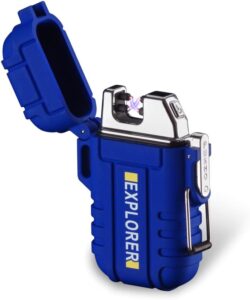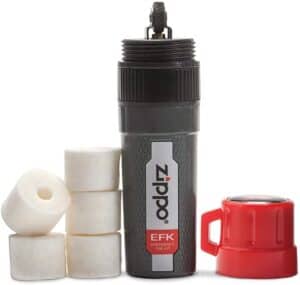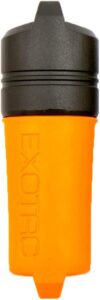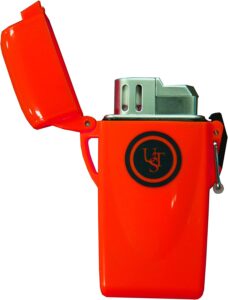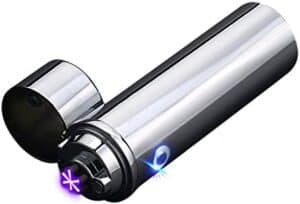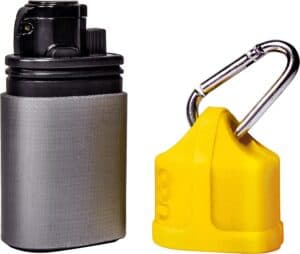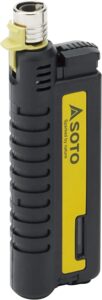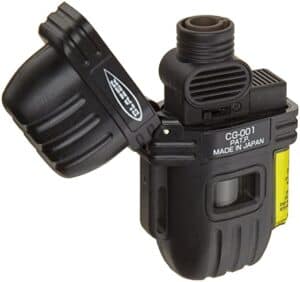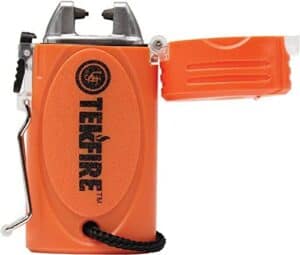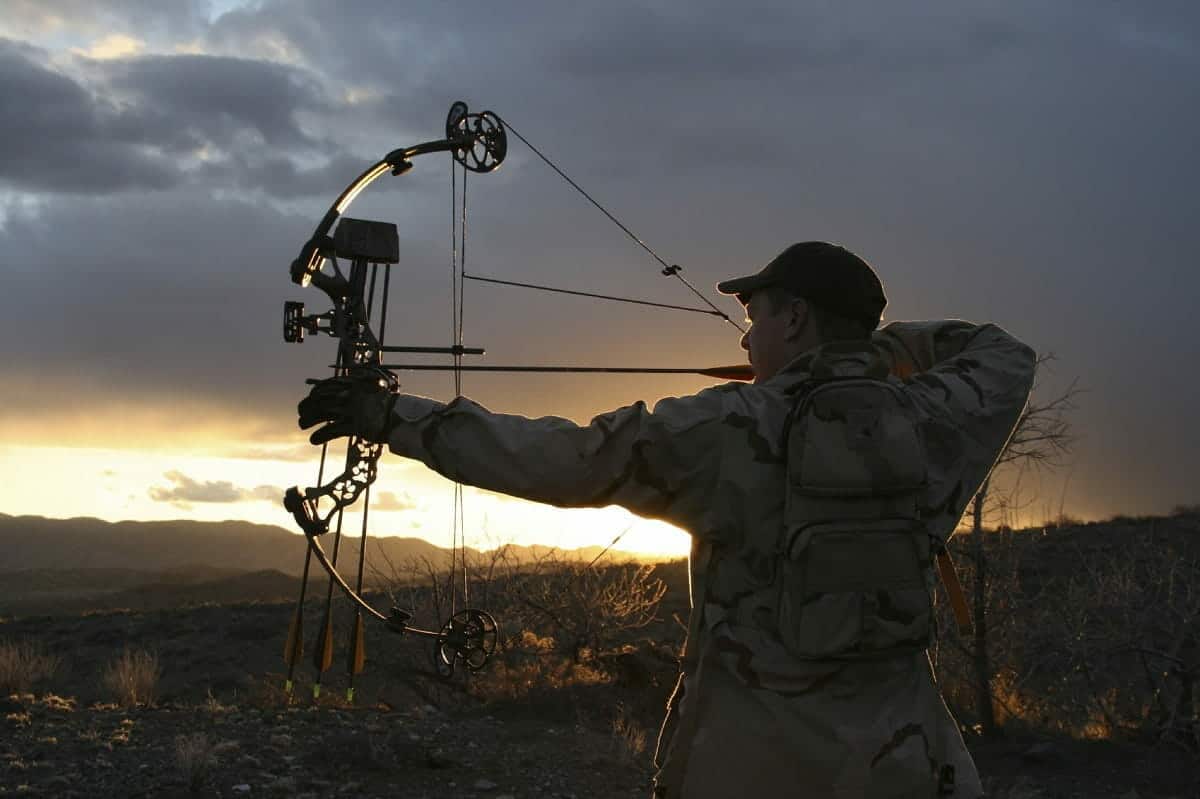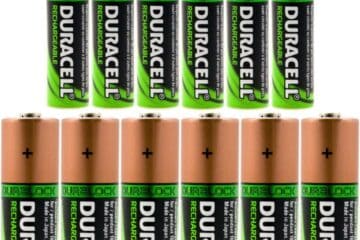When it comes to wilderness survival, there are a number of essential tools that go with you everywhere. Having at least one reliable method for starting a fire is a must, and many experienced hikers, hunters, and outdoor enthusiasts bring multiple fire starting tools on their excursions. A survival lighter is the perfect tool to rely on when you really need a fire to cook or stay warm in the wilderness.
Our list of the Best 9 Survival Lighters gives you plenty of options to choose from. After we break down the best survival lighters on the market today, we’ll explain the most important factors to consider when buying a survival lighter in our Buyer’s Guide section. Also, be sure to read through the Frequently Asked Questions to learn about the most common concerns regarding this essential survival tool. So, without further ado, let’s get to the lighters:
1. Dual Arc Lighter
Perfect for backpacking, hiking, and hunting, the Dual Arc Lighter uses an internal lithium-ion battery instead of liquid fuel. The battery is easily rechargeable via USB port and can be utilized at any altitude without the need for an oxygen intake adjustment. The lighter is started with a simple push-button operation and contains a blue indicator light that lets you know when it’s turned on.
This survival lighter is also great for kayaking or backpacking in extremely wet conditions. The external housing features a compact, impact-resistant ABS Zinc alloy design that fits easily in your pocket. The O-ring sealed cover and locking clasp make the lighter both buoyant and waterproof, retaining the lighter’s functionality in even the wettest conditions. Finally, this lighter can withstand winds up to 80 mph and comes with a 10-second time-out safety feature to make sure you don’t drain the battery unnecessarily.
2. Zippo Emergency Fire Starter
Zippo is one of the most recognized lighter brands in the world. They’ve been around since 1932 (1) and have manufactured more than 550 million windproof lighters in their storied history. This emergency fire starter is perfect for generating a fire when warmth is quickly becoming a matter of life and death.
The Zippo Emergency Fire Starter uses a flint wheel to generate a spark. These sparks then allow you to ignite one of the four frayed wax tinder sticks that are included in the starter. The reliable spark works in all weather conditions and the tinder sticks have a perforated spine so that they can easily be torn for quick lighting. The starter’s housing is water-resistant and will float if dropped in water. This survival lighter receives the prestigious Seal of Approval from the North American Hunting Club.
3. Exotac FireSLEEVE Waterproof Lighter
Designed for water-based excursions but still perfect for backpackers, hikers, and hunters, this survival lighter remains waterproof even after it has been submerged to three feet for up to 30 minutes. The case is also designed so that it floats in water if dropped.
The Exotac FireSLEEVE Waterproof Lighter is made in the USA. It boasts a unique gas-lock feature that allows you to keep it on without continuously depressing the gas button. In addition, this lock protects the lighter’s gas button from being pressed accidentally. This feature eliminates the unnecessary waste of precious liquid fuel.
4. UST Floating Lighter
The UST Floating Lighter is a buoyant, waterproof wilderness lighter designed to maintain optimal performance at elevations up to 8000 feet. It maintains performance as you climb using an adjustable flame that provides proper oxygen mix for your conditions. This makes it an ideal choice for backpackers and hunters that need a lighter to perform in mountainous environments.
This survival lighter boasts an O-ring sealed cover and locking clasp to keep water from damaging its critical components. The exterior casing is made of durable, impact-resistant ABS plastic (2). The lighter’s piezo-electric ignition (3) helps to guarantee performance in adverse conditions. This lighter produces a windproof flame that burns at 2000 degrees Fahrenheit. The lighter utilizes quadruple-refined butane and boasts a fuel capacity of 0.04 ounces.
5. Saberlight Sparq Plasma Lighter
This survival lighter is designed for adventurers that don’t want to rely on a flame that can be affected by wind. This plasma lighter is flameless and features a triple arc plasma beam to light larger items, such as tinder, pine needles, and small sticks. The plasma beam runs on a lithium-ion battery, which is rechargeable via the included cable.
The Saberlight Sparq Plasma Lighter features a windproof and splash-resistant design to keep the lighter’s internal battery and plasma components safe from the elements. The lighter also boasts easy operation via a simple, ON/OFF switch.
6. UCO Stormproof Torch
The UCO Stormproof Torch is a field-tested and proven survival lighter that runs on butane fuel and produces a triple jet, windproof, waterproof, and adjustable flame. It’s a refillable lighter, which makes it an excellent choice for any outdoor enthusiast looking for a lighter that will end the search for all lighters in the future. The added bonus of this lighter coming with three feet of utility tape doesn’t hurt either!
This survival lighter actually comes in two styles. The first style features the utility tape, which easily tears off and adheres to just about anything. The second style comes with an incorporated bottle opener. The lighter will hold enough butane for about 700 ignitions and the incorporated piezo-electric ignition system lasts for more than 30,000 uses. Finally, this lighter boasts durable ABS and silicone construction.
7. Soto Pocket Torch
The Soto Pocket Torch is actually a lighter “attachment.” It doesn’t include a lighter itself, but it will take a normal disposal lighter and supercharge its performance. It’s a cheaper alternative to transform a normal lighter into a survival lighter and, in doing so, increase its lifespan by as much as 60 percent.
This pocket torch is best used at altitudes under 5,000 feet, but it features a strong, wind-resistant burner and powerful electric ignition. Great for lighting stoves and lamps or soldering metal and melting snow, this powerful torch produces a flame that can reach temperatures up to 2300 degrees Fahrenheit.
8. Blazer CG-001
This survival lighter has applications beyond simply lighting cigars, pipes, and cigarettes, although you can certainly use it for those purposes as well. It’s a butane-refillable torch lighter that boasts a wide flame and comes in a durable housing that makes it ideal for outdoor use. It comes with a clear view fuel gauge so that you know before you run out of butane.
The Blazer CG-001 boasts a flip-top safety cover and a key ring latch for easy, one-touch operation. It houses a piezo-electric ignition system, which utilizes a pressurized molecular reaction to provide a reliable spark every time. Additionally, this survival lighter produces a wind-resistant flame that can reach temperatures up to 2,500 degrees Fahrenheit.
9. UST Tekfire Lighter
The UST Tekfire Lighter boasts a lightweight design and easy-starting operation that makes it ideal for backpacking, camping, and hunting trips. The lighter uses an electric arc to provide a wind-resistant, flameless ignition source. All essential components of this lighter are housed in a rubberized case that allows for easy grip and comes with a wrist lanyard to attach for safety.
This survival lighter runs on a built-in, lithium-ion battery, which means it doesn’t require butane fuel or need flame adjustments at higher altitudes. The 300-mAh battery is rechargeable via any USB port using the included cable and the Tekfire boasts a green indicator light that lets you know when it’s in use. It also features a 10-second time-out safety feature that reduces overall battery usage.
—
Buyer’s Guide
Man’s mastery of fire has been one of the major developments in human history (4). Our ability to manufacture warmth in the outdoors is still vital to making our backpacking, hunting, and camping trips much more enjoyable, not to mention its applications for cooking delicious meals in the backcountry.
Selecting a reliable survival lighter is arguably one of the most important gear choices you’ll make. In this Buyer’s Guide, we will highlight the most important factors to keep in mind when choosing between the best survival lighters on the market today. Let’s look at what you need to keep in mind when selecting a survival lighter:
Quality of Construction
Survival lighters are preferable to their disposal counterparts because they are more rugged and capable of being tossed around a bit. But all survival lighters aren’t created equal and some are made with cheaper plastics that can easily crack when dropped or exposed to severe elements. When we say cheap plastic, we’re talking about precisely the kind of plastic used in most durable lighters.
When you’re evaluating survival lighters, ‘ABS’ is a term you should keep an eye on. ABS, or Acrylonitrile Butadiene Styrene, is an opaque thermoplastic and amorphous polymer. The main benefit of this plastic is that it can be heated to its melting point, cooled, and re-heated again without significant degradation. There are other types of lightweight polymers used in the construction of survival lighters today, but ABS is the most common example.
In addition to durability, the quality of a lighter’s construction plays a role in its overall weight. For ultralight backpackers, hikers, and hunters, every ounce counts. If you can find a polymer that’s just as strong as ABS but considerably lighter, for example, you might be able to reduce your overall pack weight.
Resistance to the Elements
Ultimately, the lighter you choose needs to be resistant to the types of elements and environments it’ll be subject to once it’s in use. A true survival lighter needs to maintain its function regardless of external conditions, so its level of resistance is one of the most important factors to consider when comparing survival lighters against one another.
The materials used in the lighter’s construction obviously play a role in its level of resistance. The type of plastic used will determine its durability when dropped. The design of the cover will tell you how much it’ll maintain resistance to water and dust. The strength of the flame when used in high-wind situations will tell you whether the lighter is really going to work when you need it most.
When you’re looking at a lighter’s level of resistance to the elements, take some time to consider the situations in which you might use it. If you live in a particularly rainy area, for example, waterproofing is a huge priority. If this lighter will go with you on strenuous mountaineering expeditions, on the other hand, finding a flame that will work in heavy winds is paramount.
Use and Reuse
One of the major advantages of a survival lighter is its ability to be reused over and over again. By nature, survival situations are unexpected and highly variable. If you find yourself in one of these situations, you don’t want to be relying on a fire starter that’s only made for a single use or a disposable lighter that could run out of fuel.
After all, the point of buying a survival lighter is so that you’re prepared for ANY survival scenarios that could arise in the future. Choosing a lighter, therefore, that is either refillable or rechargeable is a smart selection.
Types of Fuel
The last factor we’ll discuss in this guide is choosing between the types of fuel survival lighters use to function. This choice can determine how useful your lighter is when you need it and also plays a role in how easy it is to refill. Certain fuels are more accessible than others, and recurring cost also has to be factored in. Generally, there are four types of fuel we’ll discuss: lighter fluid, butane, electric/arc, and plasma.
Lighter fluid is the most accessible of these fuel types. It is a combustible fuel that you’ll be able to pick up for refill purposes at your local grocery, convenience, or outdoor store. Convenience is the biggest benefit with this fuel type, as it tends to be more wasteful than its counterparts. Additionally, most lighters that utilize lighter fluid don’t have windproof flames or require frequent refills.
Butane is another combustible fuel type. This is the most common fuel type found in windproof lighters. Butane burns hotter and faster than lighter fluid, which means lighters that use this fuel type need to be refilled more frequently. Butane is also a little less accessible than lighter fluid, but most outdoor outfitters will carry it for refill purposes.
Lighters that use an electric ignition, or arc igniter, do not require combustible fuel at all. They operate on battery power, some of which are disposable. Most survival lighters, however, include rechargeable internal batteries and those that do tend to be more resistant to wind and water splashes because of the lack of a flame. However, lighters that use an electric or arc fuel source require access to a power source or portable solar panel and generally need to be recharged quite frequently.
Plasma lighters function in largely the same manner as electric lighters. They run on batteries that can be recharged. They don’t rely on an extinguishable flame. And they provide greater resistance to wind and moisture. From a scientific standpoint, there is some debate over the technical differences of plasma and electricity (5), but for all practical purposes, lighters that use these fuel sources function almost identically.
Frequently Asked Questions
Survival lighters should be cared for and handled differently than disposable lighters. They are, of course, made for survival purposes and should be treated as such. In this Frequently Asked Questions section, we’ll answer some of the common concerns about survival lighters and provide some insights into the best ways to use and maintain your new lighter.
What are the uses for a survival lighter?
Some of the main uses of a survival lighter include, but aren’t limited to, making a fire to stay warm, cooking food, boiling and sterilizing water, illuminate your camp and surrounding areas, and keeping potential predators away.
What makes a survival lighter different from a disposable lighter?
There are many factors that make survival lighters different from disposable ones. In general, however, survival lighters are more durable, more resistant to the elements, and more capable of delivering a reliable ignition source than disposable lighters.
Can I use a non-recommended fuel type in my survival lighter?
Generally, it is not recommended to stray from a manufacturer’s recommendation unless you have considerable experience with fuel types and how to harness their power with the specific survival lighting instrument you’ll be using. With a Zippo lighter, for example, gasoline and diesel fuel can, in theory, work, but it isn’t recommended to try unless in dire conditions.
How long do electric lighters need to charge and how many times can I use it on one charge?
This will vary depending on the specific manufacturer and design of the electric lighter you’re considering. The Arc Lighter (#1 on our list), for example, requires about two hours to be recharged and can be used about 90 times on a single charge. That’s based on an average of 8 seconds per light.
Should I ever worry about cleaning my lighter?
Yes, but doing so requires you to look into the specific cleaning instructions recommended by your lighter’s manufacturer. Electric and plasma lighters, as you might imagine, require different cleaning approaches than you’d use for a traditional butane lighter. Electric lighters can actually require more regular cleaning because of the importance of keeping the tip clean at all times.
Over time, a residue can buildup on an electric lighter’s ceramic tip and hinder its performance. To clean this residue, use a clean and dry toothbrush to gently brush it away. Avoid any heavy abrasives or liquid cleaner. Regular cleaning will prevent excess buildup and make it easier to keep the lighter performing at its optimal potential.
Butane lighters also need to be cleaned at semi-regular intervals. They require care less often because they tend to have less moving parts, but still need to be bled and cleaned to any residual film that is deposited when the butane is burnt. It’s recommended to clean your butane lighter every few months (6).
How does altitude affect butane lighters?
The major factor that impacts lighters at altitude is thin air. Fire needs oxygen to burn. As you move higher in elevation, there is less oxygen and, subsequently, many butane lighters can begin struggling to create and maintain a strong flame. In addition, strong winds also become an increasing factor as you climb higher in elevation in most places. For these reasons, many high altitude expeditions carry flameless survival lighters that rely on an electric or plasma ignition source.
Summary
Once you choose a new survival lighter, you’ll be able to rest easy knowing that you’re prepared for those unpredictable events that can happen when spending time in the great outdoors. As the saying goes, “It’s better to have it and not need it, then to need it and not have it.” We hope you’ve enjoyed this article highlighting the best survival lighters and the important factors to consider when choosing yours. We wish you the best of luck in your future adventures!
